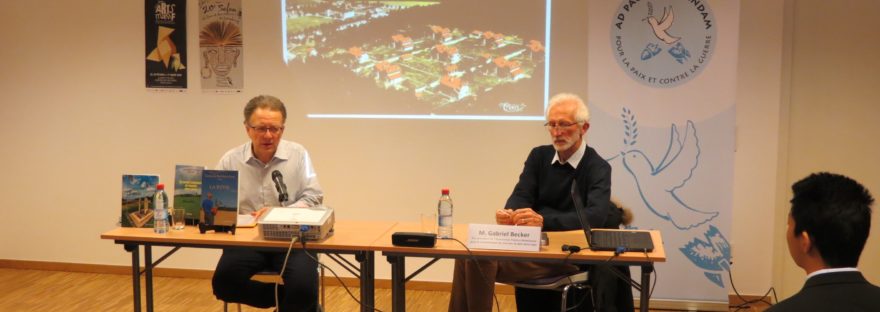The Ban Saint-Jean camp in Moselle (F)
On Saturday 29 February 2020, our association “For peace and against war” invited Mr Gabriel Becker, from Lorraine, to present the Nazi camp of Ban St-Jean in Moselle (F) on the 20th “Salon du Livre et des cultures” in Luxembourg. This camp is in fact a mass grave containing the remains of 20,000 Soviet prisoners of the Second World War.
Before giving the floor to the guest, the President of the Association, Mr Claude Pantaleoni, introduced Mr Becker and his research work within the AFU (French-Ukrainian Association), which is responsible for the rehabilitation of the camp.
The mass grave of Ban St-Jean is in Moselle, near Boulay, about one hour from Luxembourg. Gabriel Becker, a retired German teacher, has been researching testimonies, archive documents and memorabilia for twenty years to save the history of this Soviet prison camp from oblivion. He is vice president and co-founder of the Franco-Ukrainian Association (AFU), which works to preserve the camp.
Becker has published four books in which he explains the drama of the last world war and the ups and downs of the camp’s rehabilitation.
Nazi transit camp
The speaker began by explaining that the local population did not want to deal with this camp after the war and did everything they could to forget the place, partly because the people were worried about their survival and were busy with the difficult organisation of their daily lives.
Before the war, between 1934 and 1936, the St-Jean camp was set up as a security camp as part of the fortifications of the Maginot Line, i.e., it was a camp intended to receive the wounded and dead of the Maginot Line a few kilometres away. As it had to provide new men, it took on a strategic role, even though the Nazi army bypassed the Maginot Line and passed through Belgium to attack France.
The camp covers an area of 100 hectares and is in the countryside near a forest. It was crated from expropriated private land in the municipality of Denting.
Using historical photographs, Mr Becker reconstructed the origin and development of the camp, which was first occupied by the 146th RIF of the French army. After the French surrender in June 1940 German Nazi soldiers took over the camp. The first prisoners were French, including François Mitterrand, who spent a few days there.
300,000 Soviet prisoners
In June 1941 Hitler launched the Barbarossa attack against the Soviet Union and the first Soviet prisoners arrived in Lorraine and on the Ban St-Jean. Almost every day, Soviet prisoners in a state of extreme physical decay reached Bolchen station. The luckiest among them were able to work for the farmers in the region. They were “lucky” because they were fed a normal diet, which did not apply to the camp inmates. For the biggest problem in the camp was the enormous lack of food. This regularly led to epidemics (cholera, typhus, etc.) among the weak and often sick prisoners. Accordingly, the mortality rate was very high. From 1941 to 1944, about 300,000 Soviet prisoners lived in Ban St-Jean. As soon as their physical condition allowed it, they were distributed to the iron and coal mines of the region.
At the end of the war, about 204 mass graves with 80 to 100 victims per grave were discovered, which means more than 20,000 bodies in total. According to Gabriel Becker, this makes Ban St-Jean the largest Nazi mass grave in France, even though it was not an extermination camp but a transit camp.

Moscow stops Ukrainian commemoration ceremonies
After the war, the Ukrainian community took on the task of establishing a cemetery on Ban St-Jean. The Ukrainians laid out a cemetery with a gravestone around the mass graves and organized an annual memorial service in honour of their dead compatriots.
But Moscow – in the time of the USSR – did not like these ceremonies. It did not allow to member states of the Soviet Union to participate in such ceremonies outside the official ways. It did not allow Ukrainians in the diaspora to show their nationalism. Therefore, Moscow put pressure on the French government to stop the public celebrations. The French Government gave in by setting up a Soviet cemetery in Noyers-St-Martin to lay to rest the Soviet dead scattered throughout France. In 1979 and 1980, the French government organised the exhumations in three phases. The exhumed bodies were transferred to the new necropolis in Noyers-St-Martin, in the Oise region near Beauvais. The proximity to Paris made it easier for official representatives to travel there.
But since then, Mr Becker still has a problem: “only 2,879 victims have been exhumed… and the announced figure of 20,000 or 22,000 victims is a suspicious undercutting. In 1980, the French government declared Ban St-Jean a “clean” place, so from that time on, no more commemorations were held there”.
On an autumn day in 2000, when the mayor of Denting declared that an incinerator was to be built on the site of the former concentration camp to dispose of the sludge from the sewage treatment plants of the entire Moselle department, the population again remembered the dead.

Stele for the 22,000 Ukrainian victims
At that time Mr Becker was a member of an environmental protection association, which immediately opposed the construction. The mayor of Boulay also opposed the construction of the incinerator. Knowing Mr Jean-Pierre Masseret, the Secretary of State of Veterans, he visited him in Paris. There, he was able to convince the Secretary of State that it was not appropriate to have this plant built, as the site had been used as a transit camp for political prisoners during the Second World War and thousands of bodies were still buried in the ground. The Secretary of State took the side of the factory opponents. He appealed to Mrs Malgorne, prefect of Moselle, to stop the project. He literally called on her to “stop the project out of respect for the memory of all the victims of the camp. And although many bodies have been exhumed, my services cannot guarantee that there will be no more bodies”. Mr Becker and his team took the initiative and had a stele erected to make Ban St-Jean a place of remembrance again. The stele bears the inscription “To the 22,000 Ukrainian victims of Ban St-Jean”.
On the basis of numerous documents, Becker explained what is important so that the descendants of Soviet prisoners can visit the burial place of one of their ancestors. Some descendants could be found in Russia or Ukraine and then came to visit Ban St-Jean. The camp itself was completely razed to the ground after the Second World War, leaving only the houses of officers and non-commissioned officers.
Today, descendants of the third generation still visit the Ban St-Jean, because thanks to the Internet they can locate the camp and obtain information. But before them, a whole generation was not able to honour their deceased for various reasons (Iron Curtain, no financial means, no information).
At the end of the war, many prisoners knew that if they returned to the USSR, they would be treated very badly by Stalin, who considered every survivor a traitor or coward. That is why most of them did not return to the USSR and tried to find out where they could stay in Europe. Especially France, Germany or Great Britain came into question as new homes. Many emigrated to Canada, the United States or Australia. Only a few returned to the USSR.
The forgotten “Lost Memory” (a documentary)
During the second part of the conference, Mr Becker showed a documentary film by filmmaker Dominique Hennequin from Metz (F), who had visited Ban St-Jean several times during six months. His documentary film is called “Trou de mémoire (Lost Memory) – Ban St. Jean” and describes the everyday life of the “Eastern workers”, the labour prisoners from the East. It can be viewed on the Internet (www.filmsdocumentaires.com/films/4020-trou-de-memoire).
The film captures a forgotten page of history, captures a collective “hole of memory”. Who remembers that in 1942 every seventh inhabitant of Moselle (F) was a man or woman of Russian, Polish or Ukrainian origin? Prisoners of war or families rounded up by the Nazi occupiers during Operation Barbarossa were to use their labour to support the German war effort in the occupied territory of Moselle.
The Eastern workers worked like slaves, provided they had survived the long journey in cattle wagons, without water or food, to the Ban St-Jean near Bolchen (Boulay). In the transit camp, which took 300,000 prisoners over the years, hunger, cold and typhus killed the weakest quite quickly.
The conference ended with a current problem. Mr Becker explained that the AFU (Association Franco-Ukrainienne) had difficulties in organising the annual official commemoration ceremonies because of the war between Russia and Ukraine. In fact, Russians and Ukrainians do not understand each other anymore, even though they stay together in front of the mass graves of their dead ancestors. It has become difficult today to remember together the Soviet dead (especially Ukrainians and Russians) who lie in the mass graves. Today, official representatives of Russia and Ukraine are no longer invited to the commemoration ceremonies on Ban St-Jean.


